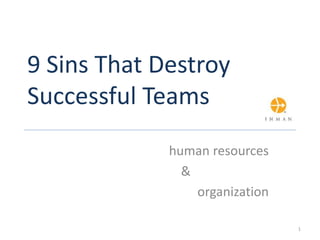
9 sins that destroy successful teams
- 1. 9 Sins That Destroy Successful Teams human resources & organization 1
- 2. 2 “ Coming together is a beginning. Keeping together is progress. Working together is success. ” Henry Ford The 3 necessary steps to create a INMAN’ culture of teamwork and collaboration. 1. Coming Together: Identify our real needs, structure our teams and their goals; most important, fill it with the right people. 2. Keeping Together: The work doesn’t stop once the team is formally appointed. We have to learn how to continually evaluate our team’s unique personality and fullest leverage it within our companies. ( Tutorship ) 3. Working Together: Collaborating effectively, through the positive and the negative, will truly bring the target of our teams to life.
- 3. 3 In 2012 we have set some teams to get alive the “ INMAN ” project, but, still now, something just doesn’t click. The appointed group of people, who are extraordinarily competent and diligent, can’t seem to get anything done and projects sink toward failure. • Why is that ? • Which are the factors that turns teams into dysfunctional groups of people ? Up to now we can identify nine key factors that turn an otherwise competent team into a sinking mess
- 4. Preliminary First we have to get very clear role & duties of the top figures that lead and manage those teams. 4
- 5. 1. EGO When someone’s ego is more important than the team, the project or the goal, things break down quickly. This happen when one person is more interested in “looking a leader” than getting the work done, when someone is always placing blame, or when someone feels and acts like signed by god instead of doing the “agreed” necessary work. ( The IKE syndrome ) 5
- 6. 2. Negative competition Lighthearted competition can be a good thing; individuals can be motivated by gamifying their work within a leaderboard but when competition goes too far, it can destroy a sense of team-work and create a “ you versus me ” atmosphere that isn’t good for anyone. 6
- 7. 3. Poor communication When the left hand doesn’t know what the right hand is doing, it causes all sorts of problems: duplicate work, forgotten work, missed deadlines, etc. Communication supported by Real, Reliable and Complete data is absolutely key to a team that works. ( inference scale effect ) 7
- 8. 4. Micromanagement When employees have to get approval or sign-off on every single thing they do, it slows down the workflow considerably. Effective Leaders need to be able to Trust Managers to make the right choices, and managers need to feel comfortable asking for help when they need it. The right balance is the key. 8
- 9. 5. Criticism without praise We have known people in whose entire management philosophy was to criticize everything and rarely, dole out praise. It is easy to imagine how well it can go over with their submissive team. “Constructive” criticism is vital to help employees’ growth, but generous trust and well timed praise is also important for maintaining a genuine enthusiasm and morale. 9
- 10. 6. Unreasonable expectations As a member of a team, nothing feels worse than the sinking feeling of knowing that you will never reach your targets, no matter how hard you work. Challenging goals that may stress a lot the team are good, but goals that are too away of reach are depressing. It won’t make employees work harder; it will make them want to give up. 10
- 11. 7. Half-hearted work Having one or more member of the team who only puts in half an effort - estranging, leaving early, checking email all day, etc. - has a decidedly negative impact on the whole team. It’s important that everyone is putting in a full, equal effort. 11
- 12. 8. Stubbornness When a dogmatic leader adopt a “ my way or the highway ” approach, no one benefits. When working in a team, everyone needs to be open to new ideas, new approaches and experimentation; even, and perhaps especially, the Leaders. “ Just because you’ve always done it that way doesn’t mean that’s the best way to do it in a changing environment “ 12
- 13. 9. Leading with emotions Instinct, emotions, and gut feelings all have their place. Bringing emotions too much into the team can have a deleterious effect. A team member who always feels spurned when his idea isn’t chosen, who sees slights, real or imagined, in every interaction, or who takes stress and anxiety about a project is bringing too many negative emotions into the workplace. 13 Emotional abuse kills confidence, creativity and individuality
- 14. Your contibution Of course, these are not the only culprits, but some of the most pervasive that I could see in the INMAN experience. What problems do teams experienced that would make sense to be added to the list ? We’ll appreciate your contributions. TKS 14
